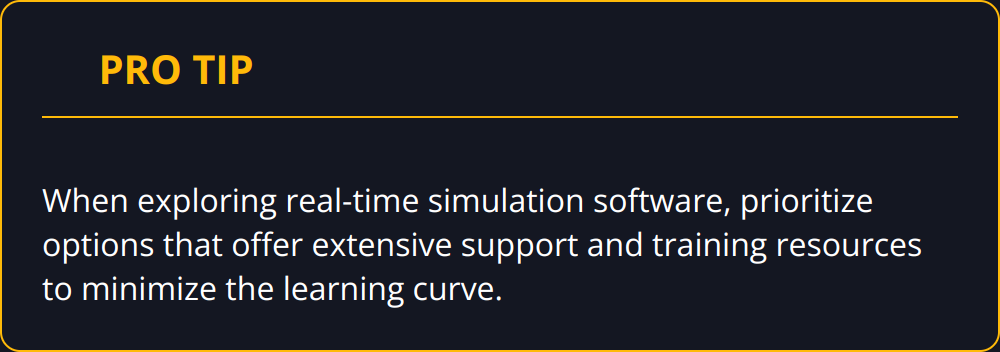We at newroom connect understand the power of cutting-edge technology in transforming business landscapes. Real-time simulation software stands as a formidable tool, bridging the gap between theoretical analysis and practical application. This comprehensive guide will navigate through its intricacies, from understanding its core to selecting the right software. Join us as we explore how this technology can revolutionize decision-making, training, and system validation across various fields.
Understanding Real-Time Simulation Software
Real-Time Simulation Software represents a transformative leap from traditional methods, allowing businesses and engineers to test and adjust their models in a live environment. This software brings a multitude of benefits, including enhanced decision-making, streamlined development processes, and more accurate system validation.
What makes Real-Time Simulation Unique?
Real-Time Simulation Software is distinctive because it operates in the same timeframe as its real-world counterpart. This immediacy means that users can see how changes affect their models instantly, which is invaluable for fields requiring quick decisions or adjustments. Some key features of this software include:
-
Immediate feedback on any alterations to the model
-
The ability to handle complex calculations in seconds
-
Integration with other systems for a holistic view
Real-Time vs. Traditional Simulation
The primary difference between real-time and traditional simulation lies in the timing and application of results. Traditional simulation often requires hours or even days to run complex models and provide outcomes. In contrast, real-time simulation offers insights almost instantaneously. Here’s why real-time simulation outpaces its traditional counterpart:
-
Speed: Real-time delivers immediate results, crucial for dynamic environments and fast-paced industries.
-
Agility: It allows for rapid iterations, enabling quicker refinement of designs or systems.
-
Accuracy: Simulating in real-time closely mirrors actual conditions, resulting in more reliable data.
For those in industries like automotive, aerospace, manufacturing, or software development, embracing real-time simulation software isn’t just beneficial; it’s essential for staying competitive. Transitioning to this technology can significantly reduce development times, lower costs, and improve product or system performance before actual implementation.
When selecting the right real-time simulation software, consider aspects such as compatibility with existing tools, the complexity of models it can support, speed, and the learning curve for team members. Tools like Creo Simulation Live by PTC and ANSYS offer intuitive, real-time solutions that integrate seamlessly into design processes, making them accessible even for those not specialized in simulation.

For further reading on selecting the right tools for your needs, check out our guide on choosing virtual reality design tools.
Adopting real-time simulation software is not merely about keeping up with technology trends; it’s a strategic decision that can drastically alter how businesses approach design, testing, and implementation processes. By understanding the differences and advantages over traditional simulation, organizations can make informed decisions that propel them towards innovation and efficiency.
Why Use Real-Time Simulation Software?
Embracing real-time simulation software propels businesses into a future where decisions are informed, training is effective, and systems are reliable. The benefits extend across multiple facets of an organization, notably in decision-making, training, and system validation. Here’s how:
Decision Making and Problem Solving Enhanced
The essence of real-time simulation lies in its ability to render immediate feedback. In scenarios where seconds matter, having the capacity to see the consequences of your decisions instantaneously is invaluable. For businesses, this means quicker response times to market changes or operational challenges. Imagine refining a product design and instantly understanding its impact without the need for physical prototypes. The speed and agility offered by real-time simulation significantly reduce the guesswork in decision-making processes, allowing for more strategic and data-driven solutions.
In practical terms, adopting real-time simulation can lead to a reduction in development time by up to 50%. This not only accelerates product launches but also enhances the overall quality and innovation of the solutions offered. More so, when faced with complex problems, the ability to iterate rapidly encourages creative problem-solving strategies that might be impossible under traditional simulation frameworks.

Training and Skill Development Revolutionized
Training and skill development take a leap forward with real-time simulation. The hands-on experience imparted through immersive simulations prepares employees for real-world scenarios better than any textbook or traditional e-learning method could. For industries like healthcare, aerospace, or manufacturing, where precision and accurate decision-making are paramount, the ability to train in a risk-free virtual environment is revolutionary.
Consider the impact on surgical training, for example. Surgeons can practice complex procedures in a simulated environment, gaining proficiency and confidence without any risk to patients. According to a study by Harvard Medical School, surgeons trained in a simulation environment were 27% faster and made 32% fewer errors compared to those who received traditional training.
System Testing and Validation Improved
Finally, the reliability and effectiveness of system testing and validation are dramatically improved with real-time simulation. In the past, validating a new system or an update to an existing one could be a lengthy and resource-intensive process. Real-time simulation, however, allows for comprehensive testing under a wide range of scenarios and conditions, without the need to disrupt actual operations.
This is particularly impactful for industries reliant on complex systems like telecommunications or energy. Being able to test system resilience or disaster response plans in a controlled, simulated environment can prevent potential failures before they happen. It’s a proactive approach to risk management, saving potentially millions in damages and ensuring uninterrupted service to customers.

In light of these significant benefits, businesses looking to stay ahead in the competitive landscape cannot afford to overlook real-time simulation software. It’s not just a tool; it’s a strategic asset that can transform operations, enhance training, and sharpen decision-making. For an in-depth look into implementing these systems effectively, our article on virtual reality training tips offers further insights.
Stepping into the realm of real-time simulation isn’t merely about adopting new technology; it’s a commitment to operational excellence and innovation. As we continue to navigate a rapidly evolving business environment, the role of this software in shaping future successes becomes ever more apparent.
Choosing Real-Time Simulation Software
Selecting the right real-time simulation software is a pivotal decision that can significantly impact your business’s operational efficiency and innovation capabilities. It’s not just about picking the most popular tool but finding the best fit for your specific needs. Here are practical insights to guide you through this process.
Key Considerations
Compatibility and Integration: The software should seamlessly integrate with your existing systems and workflows. A mismatch here can lead to increased costs and extended deployment times.
Model Complexity: Your chosen tool must be capable of handling the complexity of your simulations. Oversimplification can lead to inaccurate results, while overly complex tools may slow down your processes.
User-Friendliness: A steep learning curve can hamper adoption. Look for software that balances advanced features with intuitive design.
Support and Community: Adequate vendor support and an active user community are invaluable for troubleshooting and learning best practices.
Cost-Effectiveness: Consider both initial purchase price and long-term operating costs. Investing in overly expensive solutions that exceed your needs can drain resources.
Comparing Popular Tools
Two leading real-time simulation software tools stand out in the market: Creo Simulation Live and ANSYS.
-
Creo Simulation Live excels in providing feedback directly within the modeling environment, making it a strong contender for designers who value real-time insights without leaving their CAD platform.
-
ANSYS, on the other hand, offers a wide range of simulation capabilities that cater to more complex and varied engineering needs. It’s particularly valued for its deep analysis options and broad applicability across industries.
Choosing between them, or other tools on the market, should be guided by your specific requirements rather than overall popularity.

Evaluating Software Suitability
-
Trial and Testing: Most vendors offer free trials. Use these opportunities to test the software with actual projects from your pipeline. This firsthand experience is invaluable.
-
Check References: Look for case studies or testimonials from businesses similar to yours. These can provide insights into how the software performs in real-world scenarios.
-
Scalability: Ensure the software can grow with your business. Evaluating its capacity to handle increased loads or more complex simulations in the future is crucial.
-
Customization: Assess the tool’s flexibility. Being able to tailor the software to your specific needs can significantly enhance its usefulness.
For a deeper dive into integrating advanced simulation tools with your existing workflows, consider exploring our insights on implementing VR classrooms.
Selecting the right real-time simulation software is a critical step in leveraging technology to drive better business outcomes. By focusing on both the immediate and long-term needs of your organization, you can ensure a choice that not only enhances your current operational efficiency but also positions you for future innovation and growth. Remember, the goal is to find a solution that provides the best return on investment while fully meeting your modeling, simulation, and analysis needs.
Wrapping Up
Embracing real-time simulation software brings businesses into the forefront of innovation and efficiency, transforming how they approach design, problem-solving, and strategic decision-making. The immediate benefits, including drastic cuts in development time, enhanced product quality, and more accurate system validations, clearly display its superiority over traditional simulation methodologies. For sectors like automotive, manufacturing, healthcare, and many others, real-time simulation is not just beneficial—it’s transformative.
![Key Takeaways - Real-Time Simulation Software [Guide]](https://newroom-connect.com/wp-content/uploads/2024/02/Real-Time-Simulation-Software-Guide-5-2024-02-22-070630.1873080000.png)
The adoption of such technology facilitates a proactive stance on risk management, allows for unprecedented levels of training realism and efficacy, and significantly boosts the agility of decision-making processes. With tools like Creo Simulation Live and ANSYS, businesses can tailor their approach to real-time simulation, picking the instrument that best suits their specific needs and intricacies.
However, the journey towards fully leveraging the potential of real-time simulation doesn’t end with selecting the right software. It’s also about integrating these tools into a broader ecosystem that supports your strategic objectives. Here, newroom connect comes into play. Our platform offers a comprehensive environment for creating virtual exhibitions, showrooms, and e-learning modules, making it an indispensable asset for businesses looking to extend their digital footprint in an increasingly virtual world. From enhancing engagement through interactive experiences to offering a cost-effective alternative to physical events, newroom connect is perfectly positioned to complement your real-time simulation tools. Discover more about how we can support your journey towards digital excellence at newroom connect.
In summary, the rapid advancements in real-time simulation software underscore a pivotal shift towards more dynamic, interactive, and efficient processes across all industries. Making the most of these tools requires a thoughtful approach to selection, integration, and application, all aimed at harnessing their full potential to drive your business forward. As industries continue to evolve, those who capitalize on the capabilities of real-time simulation, supported by platforms like newroom connect, will undoubtedly lead the pack, setting new standards for innovation, efficiency, and strategic acumen.


